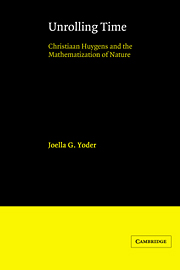Summary
In solving his physical question, Huygens had developed a sophisticated mathematical tool that rightly takes its place in the Horologium Oscillatorium as one of his great discoveries. But just as his physics went beyond the narrow problem of the constant of gravitational acceleration to a broader discussion of accelerated motion, so his mathematics moved beyond the shape of curved plates to an analysis of one of the fundamental questions of seventeenth-century geometry. What, indeed, was the significance of the theory of evolutes as mathematics?
The evolute as a purely mathematical concept has long been relegated to a role in the history of curvature, a role determined by the very definition of curvature. How, indeed, is the bending of a given curve to be measured? It seems obvious that a circle bends uniformly (that is, its curvature is constant) and that a small circle bends more sharply than a large one (that is, its curvature is greater) and, consequently, that the “curvature” of a circle might best be defined as the reciprocal of its radius. For any other curve the bending varies from point to point. Given a specific point, however, the most evident way to measure the bending is to assign to the curve the curvature of the circle that best approximates the curve in the immediate area of the specified point. The best approximating circle (labeled the “osculating circle” by Leibniz) can be derived by drawing normals to the curve at the given point and at a point infinitesimally near to it.
- Type
- Chapter
- Information
- Unrolling TimeChristiaan Huygens and the Mathematization of Nature, pp. 97 - 115Publisher: Cambridge University PressPrint publication year: 1989



